Tom
Forum Replies Created
Viewing 20 posts - 1 through 20 (of 20 total)
-
TomParticipant
@Michelle Michelle, ah yes, action shots. I’m not there yet! I’m reading manual (slow) and bought the “other” guide book too (as Kindle book) so am slowly learning things. I did buy an Amazon remote switch which I like for tripod photos (especially as I take Moon pics which are so cool!). P900 has a small light sensor and relatively “slow” lens at zoom, so full sunlight may get some good action stuff, and/or messing with ISO settings but for now, I’m using “Birdwatching” under “Settings” and I turn off the anti-shake when using a tripod.
in reply to: Activities: Exploring Birds #696838 -
TomParticipantMolly, you summed it up right there...birdwatching has a lot of “maybe” moments! And then also some of those YES times as well. It’s very humbling (a good thing in any pursuit or passion) and keeps me looking, going to the guides and other resources (like this course). I also learn so much reading the comments which puts a people-friendly spin on this course. I’ve started taking more pictures, which is itself a challenge. First I had a craigslist used $20 Nikon digital with 18x (optical) 72x (digital) zoom which was better than 7x cell phone zoom. Got hooked and bought Nikon P900 with 83x optical zoom. Wowsa! It’s been so fun to go “bird hunting.”in reply to: Activities: Exploring Birds #696627
-
TomParticipantHi Frances, I too got a chance to see, hear and record (on my phone) a Song Sparrow. I didn’t know what it was when observed. Thought “there’s a nice little brown bird with a good voice” and because I had the recording and a decent picture, was able to positively ID, and in the process appreciated the nuance in the different sparrow songs, and even the different “melodies” from the Song Sparrow. I don’t always hang on to such info, but I don’t mind relearning!
 in reply to: Activities: Exploring Birds #696621
in reply to: Activities: Exploring Birds #696621 -
TomParticipant
 What a resource! The course, the links and YOU (my classmates!) Enjoying all the info shared and personal observations and photos. Does take awhile to wade through the comments!
Very happy to know about and bookmark the Wall of Birds, I shall return. Upvoted a few, especially my fave—Great Blue Heron (we see one almost every time we paddle on Wisconsin rivers).
As I’m also taking Cornell’s Nature Journaling and Field Sketching I’m doing drawings of birds I photograph (with new Nikon P900 “bridge” camera—24-2000mm lens, “Point-&-Wow!”) Taking the time to get a good pose, and then study the details while rendering really helps me to remember a new bird, or deepen my appreciation for an old favorite. Whether in a sketchbook, in my notebook or on a scrap of paper (all represented here) it’s the PROCESS that’s key! in reply to: Activities: Exploring Birds #696610
What a resource! The course, the links and YOU (my classmates!) Enjoying all the info shared and personal observations and photos. Does take awhile to wade through the comments!
Very happy to know about and bookmark the Wall of Birds, I shall return. Upvoted a few, especially my fave—Great Blue Heron (we see one almost every time we paddle on Wisconsin rivers).
As I’m also taking Cornell’s Nature Journaling and Field Sketching I’m doing drawings of birds I photograph (with new Nikon P900 “bridge” camera—24-2000mm lens, “Point-&-Wow!”) Taking the time to get a good pose, and then study the details while rendering really helps me to remember a new bird, or deepen my appreciation for an old favorite. Whether in a sketchbook, in my notebook or on a scrap of paper (all represented here) it’s the PROCESS that’s key! in reply to: Activities: Exploring Birds #696610 -
TomParticipantHi, I love the term (and idea of) “a visual thinking style!” Thanks for sharing your process and progress and I commend you for your overall and multi-faceted approach you are taking to this “sketching course.” I too sense opportunities for personal engagement and creating a personalized record that may be shareable, but most importantly represents the full experience of observation, study and appreciation of Nature.in reply to: Jump Right in! #670232
-
TomParticipantAmy - your fox really came to life!in reply to: Giving Your Drawings Depth #652678
-
TomParticipantI found this exercise to be somewhat of a turning point for me in this class because I came to realize that my 60 second gesture drawing was VERY useful in rendering the subject at a later time. In the past, I may have considered quick sketches (more like scribbles!) as minimally useful and more of a "throw-away" drawing. After doing this exercise I feel I can trust the gesture phase to be a foundation for further development, especially if I'm choosing from a series of gesture drawings. Some of the other students commented that they felt they had captured something special in their gesture drawings (bring out some of the vibrancy, personality, even Life of their subject). I'm finding the "negative space" technique helps with critical portions of a drawing as does "seeing and drawing shapes" instead of say an "actual feather" (which is overwhelming in its detail!) gives me the confidence to keep working on the drawing. One challenge I've found, that was almost comically apparent to me was that I put considerable detail into the head of this bird before moving on to the body and when I was approaching finishing, I realized I had the proportions wrong and the bird looked "off" to me. But I really liked the head (especially area around and including eye) and didn't want to erase it. For kicks, I opened the image in Photoshop and made the head bigger. YES! I was right about the proportions. I left it as it was here, and in my notebook, wanting to archive the process and remember the lesson learned...they'll be plenty more bird drawings in my future! AND: This subject didn't originally have a discussion section and I reached out to Liz to inquire if it could be added. Liz agreed it was a useful addition and quickly added the opportunity for us to share (so come on, SHARE!) Thank you Liz--your "live" presence makes this course Extra Special!
 in reply to: Giving Your Drawings Depth #652504
in reply to: Giving Your Drawings Depth #652504 -
TomParticipantI really liked this exercise. As I often do I start the video and then stop right away and try to draw what Liz is drawing before watching the video. then after watching the video I apply her suggestions and techniques, and then compare the two drawings. I was liberal with my eraser because I wanted to get the shapes that she used to render the coloration in the body. When I did my first drawing I had no idea how to suggest that colorization on the bird. My post drawing analysis is that I am much happier with the proportions and especially the tail and beak. I hope to have the confidence or fearlessness to render colors on a bird as shapes as I really like the results.
 in reply to: Drawing What You See – Upside Down Drawing #649371
in reply to: Drawing What You See – Upside Down Drawing #649371 -
TomParticipantI liked the lesson/reminder about “negative space.” I say reminder because I’ve heard of the concept before and even “studied” it a bit while reading and doing exercises from “Drawing on the Right Side of the Brain” about 35 years ago. I found the concept very helpful applied to this science journal focus. Recently I was in California (from Wisconsin) and my granddaughter came rushing in from outside and said excitedly, “I found a bug!,” and I “humored her" and went outside to see...HOLEY MOLEY, she was right! This beautiful praying mantis was just hanging around on their patio and I took a pic, then let it crawl on my hand (I remembered from somewhere they don’t really “bite”--other than maybe decapitating their mates) and it became my subject when back in (now cold and snowy) Wisconsin. I drew a frame around it for rendering purposes so I could use the concept of negative space to help me with the complex shape. That also allowed for the insect to "break out of the frame" which I wasn't planning, but really liked the effect. I like using colored watercolor pencils, and this was the first time that I scribbled a bit of pencil pigment on the page and then dipped my water-filled brush into it. This allowed me to mix dry color a bit. An interesting experience. I finished the drawing with a few extra strokes of the pencils directly on the drawing to give a stronger accent of color.
 in reply to: Getting the Proportions Right #649315
in reply to: Getting the Proportions Right #649315 -
TomParticipantI keep going back to look at others' work when new entries are posted...came across mine again, and since I received the book on trees (National Wildlife Federation's Field Guide to Trees of North America) I learned I had incorrectly ID'd the oak on the left. It is "just" a White Oak, discerned by comparing the leaves to the Swamp Oak in the book. Since we weren't in a swamp, that should have been another clue!in reply to: The Power of Comparison #648844
-
TomParticipantI found gesture drawing very interesting and was surprised a few times on what I was able to get down based on what I saw or observed--these "surprises" were perks to keep at it. I can see how using these glimpses would be useful leading into a more refined rendering. I noted that subjects (thinking birds specifically here) look so different depending on the angle and position, I've always thought about a classic "side pose" or "wings spread in flight" as a way to depict a bird (such as our first exercise). Doing these gesture drawings of pictures of animals in motion and then actually watching animals in motion I started noticing interesting details and positions that would be nice to work on. I can tell this will take some time to become useful in the field or as "studies" for more structured works. The quick drawings don't require setting time aside for a full "art session" to apply our developing craft. Looking forward to some in the field opportunities!
 in reply to: Capturing Behavior – Gesture Drawing #648769
in reply to: Capturing Behavior – Gesture Drawing #648769 -
TomParticipantGood economy of line. Less (lines) can be more (satisfying(!in reply to: Illustrating the 3D World #648689
-
TomParticipantInspired by the "lecture" and all the wonderful shared comments and pages by fellow students, I still gave it a few days before doing the exercise. I did several hikes the past week and came to realize that even a short walk in my city has me passing dozens of different types of trees and I'm woefully unable to identify more than a few very obvious specimens. Long intro to: I chose trees. Two oaks which are growing across the street from me and are beginning their fall color transition. I never knew their names until today, and the comparison of the leaves, trunk and fruit (nuts) upped my appreciation for the Gift of Nature so close to my very small corner lot backyard. Taking the time to study the leaves, make the comparisons, then draw them and list observations has me feeling like I "got to know my neighbors." A walk around the block was stimulating and challenging. I located one tree ID book I had, and ordered another one right away. Looking forward to the process of learning to ID trees using the methods presented in this course. Hurrah!
 in reply to: The Power of Comparison #647407
in reply to: The Power of Comparison #647407 -
TomParticipantI liked your “report” as I enjoy looking at and trying to ID all birds and was told by a Serious Birder that gulls are great subjects to hone the art of seeing. They are plentiful (as you’ve noted), many of them sit still for long periods and perhaps most useful, there may be several different types (species?) in the same area which allows for comparisons to be made. I like to use binoculars and when appropriate, a small spotting scope for up-close observation. I really enjoy reading others’ entries after the chapters in this course. I wish some of the photos were clearer, it’s often hard to read what people wrote though like you, some type in the main notes. Thanks for uploading your pic and report.in reply to: Noticing Themes in Nature #647083
-
TomParticipantEnjoying this course and that it is stretching me to "take risks"with my drawing and even better, hone my seeing. On a short vacation and haven't been able to get away to sit, so I collected a few things from our walks. Seeing others' entries and comments has me excited to sit in my own backyard and begin to see it in new ways.
 in reply to: Opening Your Senses #646727
in reply to: Opening Your Senses #646727 -
TomParticipantMe too, some of my single lines were better, too many strokes sometimes muddies things up. I do know from experience drawing moon craters while looking through a telescope that it gets better with repetition and also that it will take many, many times of doing something as simple as drawing an accurate oval (for the craters) that depicts what I'm looking at.in reply to: Illustrating the 3D World #646472
-
TomParticipantGettin' down & dirty (ie, too much pencil, shading, color, etc!) Enjoyed the explanation of shadow (and learning that new, cool word "chiaroscuro") and I can see that this parameter--shading--will take a lot of practice yet will lead to drawings that I will come to enjoy more (the process and the end project).
 in reply to: Illustrating the 3D World #646470
in reply to: Illustrating the 3D World #646470 -
TomParticipantGreat Citizen Sciencery!in reply to: Illustrating the 3D World #646469
-
TomParticipant
 Enjoyed seeing others' contributions...we all see and render differently and then of course there's the relationship with the pencil (forgiving, correctable) & then pen (INK! oh my!). Adding color is fun, scary too, and often I go too far and things get muddy...find it's helpful to take a pic of the drawing before applying color, then I have that for my records and also could print out and try another go at colorization, including using different mediums...
oh...THOSE questions: I noticed the subtlety of the yellow coloring, the black feather tips and I really liked drawing the branch too. in reply to: Jump Right in! #646143
Enjoyed seeing others' contributions...we all see and render differently and then of course there's the relationship with the pencil (forgiving, correctable) & then pen (INK! oh my!). Adding color is fun, scary too, and often I go too far and things get muddy...find it's helpful to take a pic of the drawing before applying color, then I have that for my records and also could print out and try another go at colorization, including using different mediums...
oh...THOSE questions: I noticed the subtlety of the yellow coloring, the black feather tips and I really liked drawing the branch too. in reply to: Jump Right in! #646143 -
TomParticipantHi Artists- Glad to have discovered this course and this community. I’m inspired (into ACTION) by the musings and dabbling of others, the celebration of PROCESS and the absolutely true adage that there is no wrong way to delve into something that beckons involvement. I signed up for this course, also bought an incredible book someone recommended (“The Laws Guide to Nature Drawing and Journaling”) AND it all is happening during “Inktober2019” (check it out!) so it’s going to be a very draw-y month for me. I really enjoyed listening to the artists in the videos who shared their journals and thought process, and also all these comments from the community. NO shortage of inspiration, affirmation and very comforting to have the connection(s). THANKS! - Tom in Wauwatosa, WIin reply to: Style Your Journal Your Way #645977
Viewing 20 posts - 1 through 20 (of 20 total)

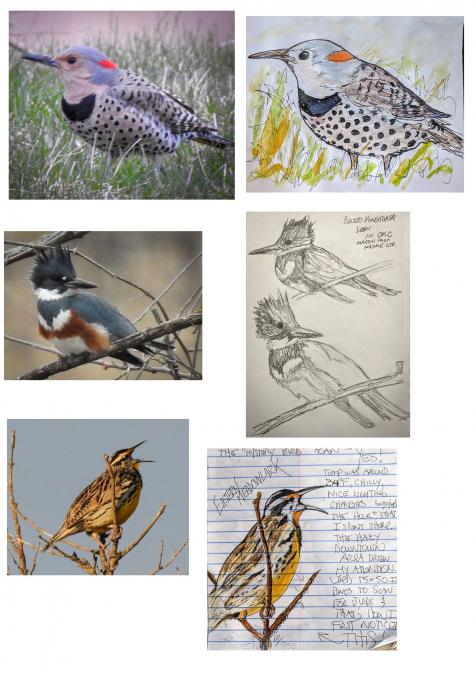 What a resource! The course, the links and YOU (my classmates!) Enjoying all the info shared and personal observations and photos. Does take awhile to wade through the comments!
Very happy to know about and bookmark the Wall of Birds, I shall return. Upvoted a few, especially my fave—Great Blue Heron (we see one almost every time we paddle on Wisconsin rivers).
As I’m also taking Cornell’s Nature Journaling and Field Sketching I’m doing drawings of birds I photograph (with new Nikon P900 “bridge” camera—24-2000mm lens, “Point-&-Wow!”) Taking the time to get a good pose, and then study the details while rendering really helps me to remember a new bird, or deepen my appreciation for an old favorite. Whether in a sketchbook, in my notebook or on a scrap of paper (all represented here) it’s the PROCESS that’s key!
What a resource! The course, the links and YOU (my classmates!) Enjoying all the info shared and personal observations and photos. Does take awhile to wade through the comments!
Very happy to know about and bookmark the Wall of Birds, I shall return. Upvoted a few, especially my fave—Great Blue Heron (we see one almost every time we paddle on Wisconsin rivers).
As I’m also taking Cornell’s Nature Journaling and Field Sketching I’m doing drawings of birds I photograph (with new Nikon P900 “bridge” camera—24-2000mm lens, “Point-&-Wow!”) Taking the time to get a good pose, and then study the details while rendering really helps me to remember a new bird, or deepen my appreciation for an old favorite. Whether in a sketchbook, in my notebook or on a scrap of paper (all represented here) it’s the PROCESS that’s key! 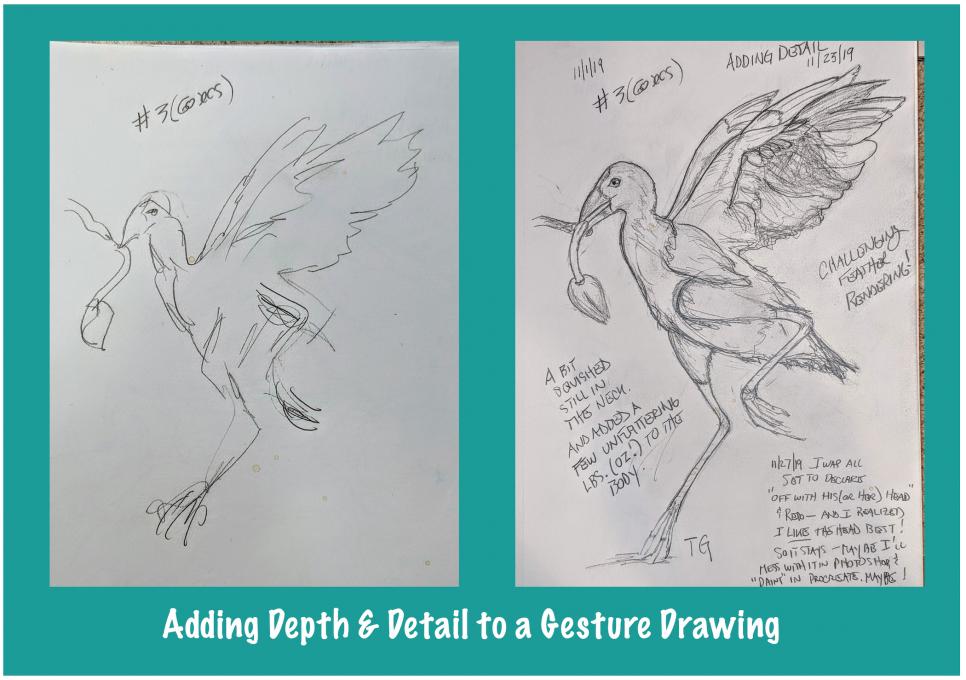

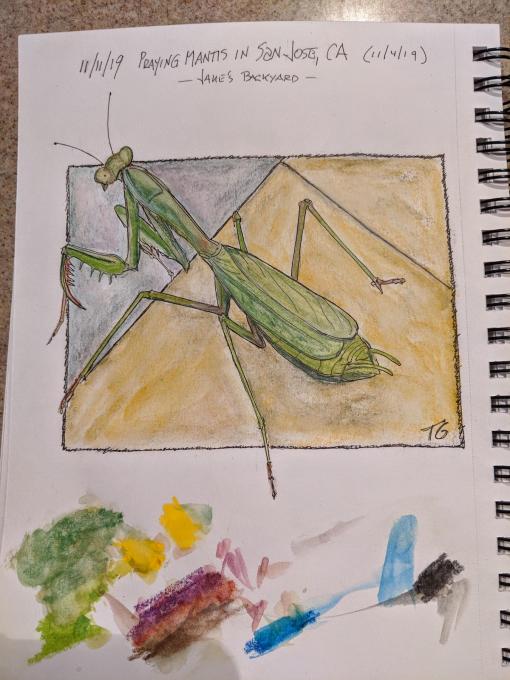
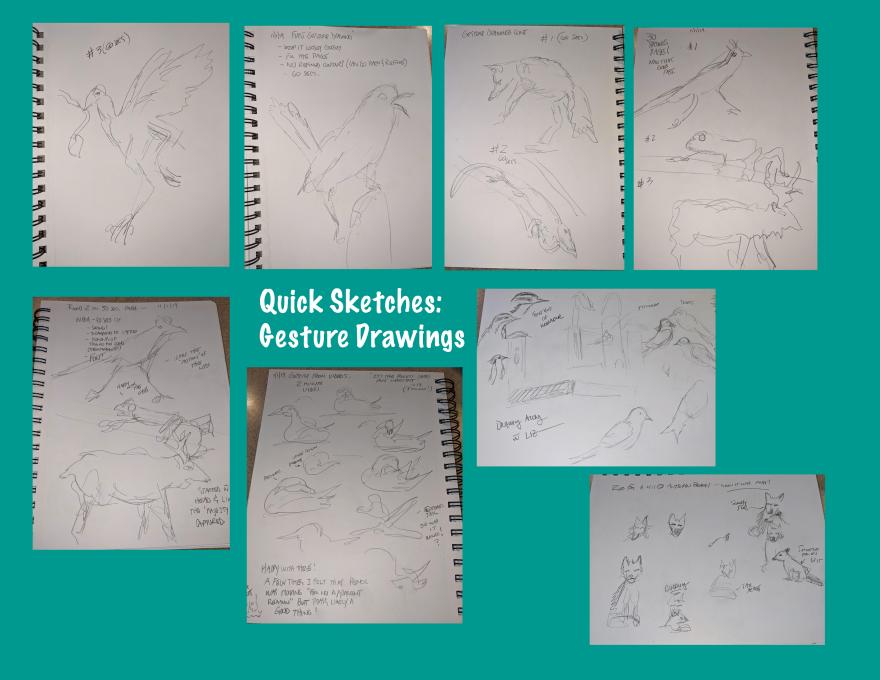

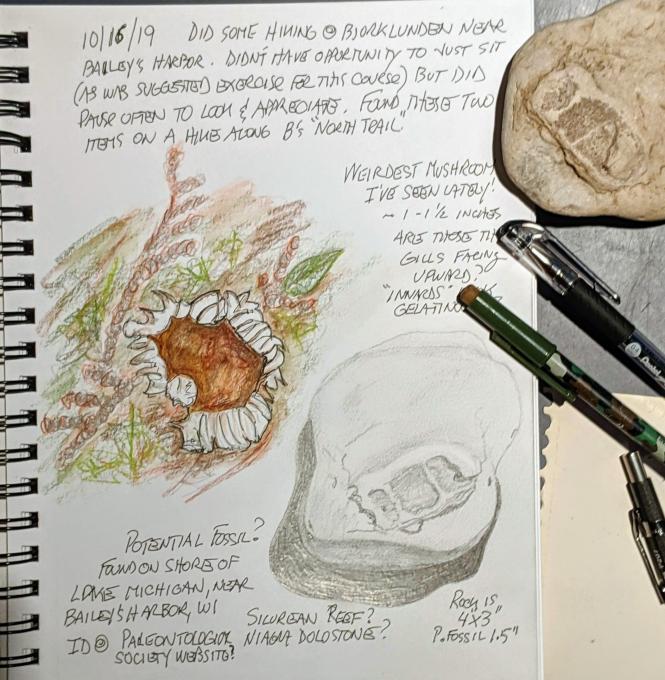

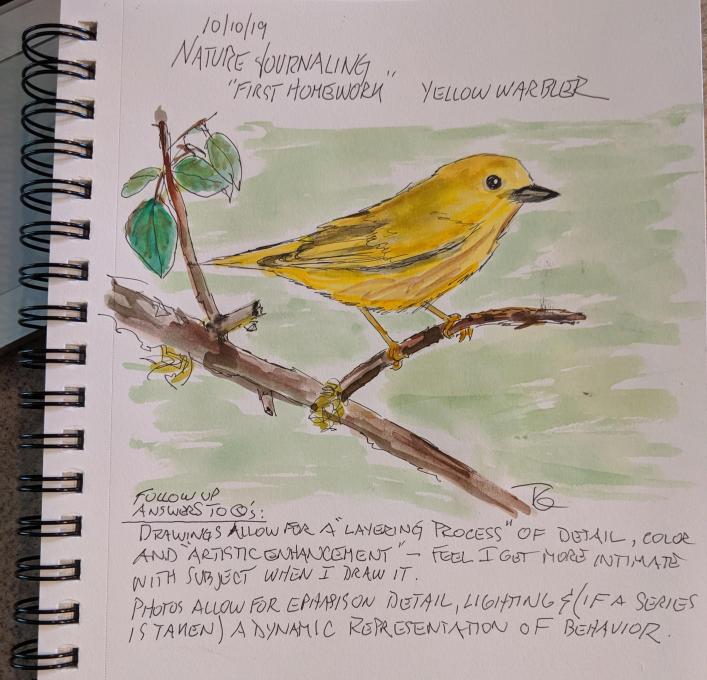 Enjoyed seeing others' contributions...we all see and render differently and then of course there's the relationship with the pencil (forgiving, correctable) & then pen (INK! oh my!). Adding color is fun, scary too, and often I go too far and things get muddy...find it's helpful to take a pic of the drawing before applying color, then I have that for my records and also could print out and try another go at colorization, including using different mediums...
oh...THOSE questions: I noticed the subtlety of the yellow coloring, the black feather tips and I really liked drawing the branch too.
Enjoyed seeing others' contributions...we all see and render differently and then of course there's the relationship with the pencil (forgiving, correctable) & then pen (INK! oh my!). Adding color is fun, scary too, and often I go too far and things get muddy...find it's helpful to take a pic of the drawing before applying color, then I have that for my records and also could print out and try another go at colorization, including using different mediums...
oh...THOSE questions: I noticed the subtlety of the yellow coloring, the black feather tips and I really liked drawing the branch too.